Finally at Flores

From Bonerate, it’s a one day motor sail south to the island of Flores. Arriving here is a loong time coming for Ausbos, instead of meeting Graham's parents at Flores back in 2019, we sailed back to Darwin as covid broke out. Jurassic Park like green mountains welcome us and I cannot remember the last time I was so excited to arrive at a new island. Finally!
We choose the small village of Riung on the north coast of Flores as our port of arrival. Riung is surrounded by the Seventeen Islands Marine Park and seems like a good spot to leave the boat for some land based exploration further east instead of backtracking eastward by boat.
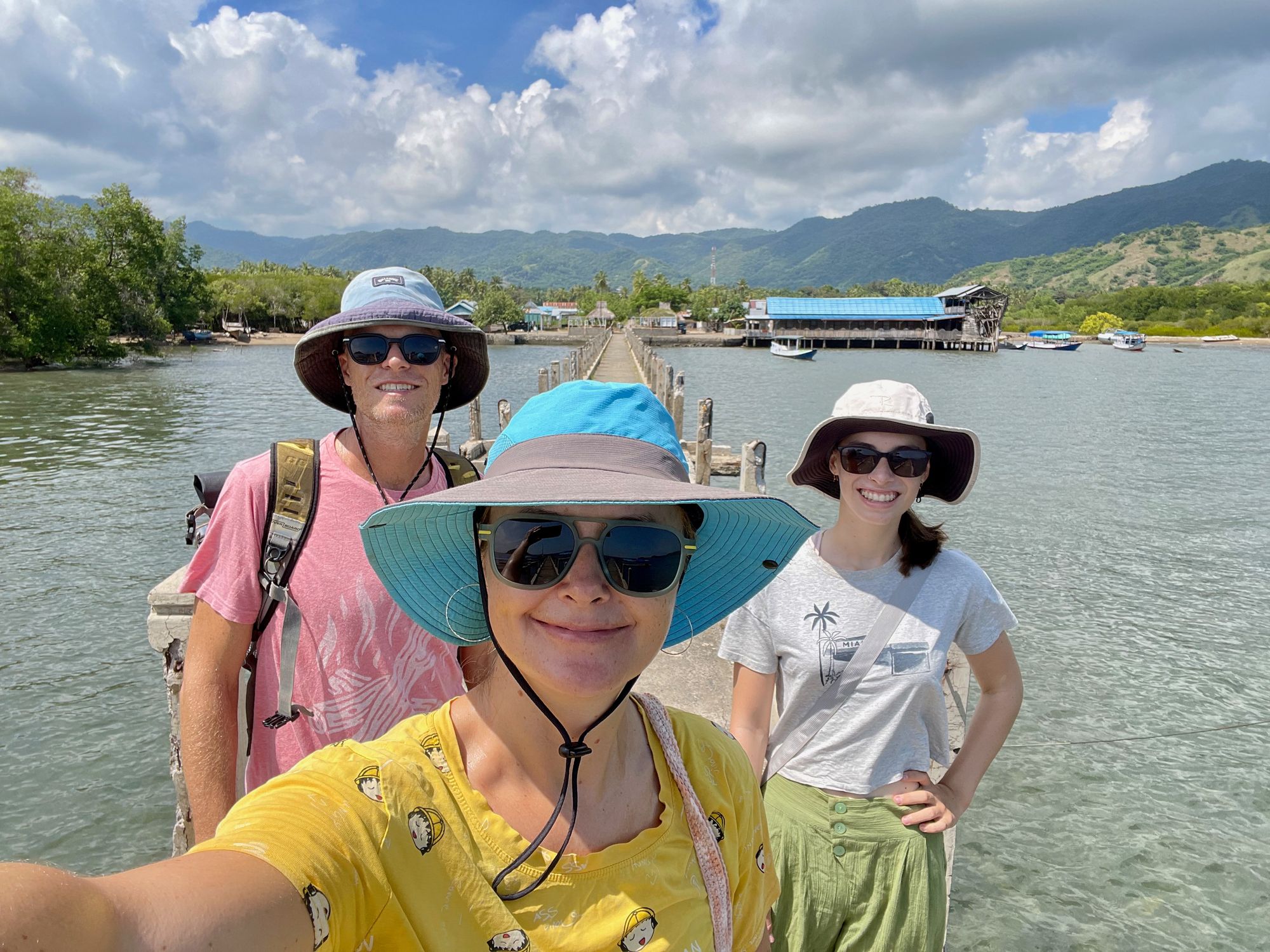
We spend a few days just chilling in the islands with Wild One then it's time to head into Riung to see about food and touring. Riung is a one main street kind of village with a very long dock and beautiful green mountains in the background.
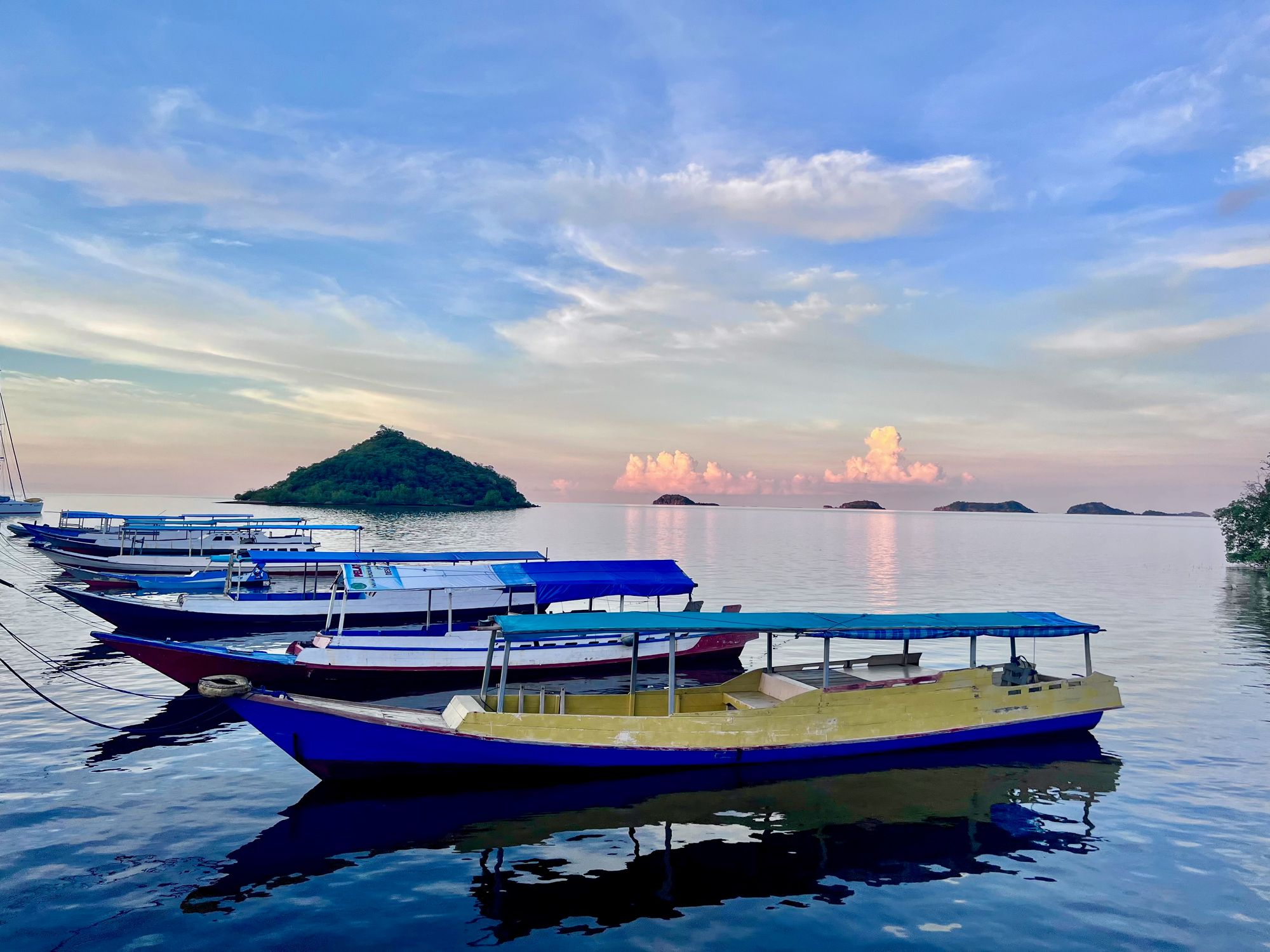
The plan is to hit the local market on this first day and perhaps get a bite of local cuisine, but as soon as I get in touch with a local hostel owner Paul he organises a car and a driver for us within the hour. Markets will have to wait, instead we’re heading to a traditional village called Bena, settled in the central Flores highlands a couple of hours south of Riung.
Paul, who is a Christian, belongs to an ethnic group quite distinct to the Muslim Indonesians from Java who have settled here. It's a similar story across Indonesia, where millions from Java and it's neighbouring islands of Bali and Medura migrated to all corners of the Indonesian archipelago as part of government-sponsored transmigration policy to reduce overpopulation and improve the situation of the migrants by moving them to less populated areas. As we drive through the village, Paul tells us that the Muslims and Christians in Riung all get along very nicely, with Muslims fishing families settled nearer to shore and the farming Christians further inland. There are several mosques and churches happily coexisting along the main road and while harmony prevails in Riung, the consequences of the transmigration program across the rest of the country are not always positive.
Back to Riung - goats and cows greet us at every corner in contrast to other places where livestock is rare and skinny chickens rule the farm. Corn fields surround the village and further afield, lusciously green rice terraces dominate. We stop for lunch in some town on the way and a couple of hours later arrive in Bena.
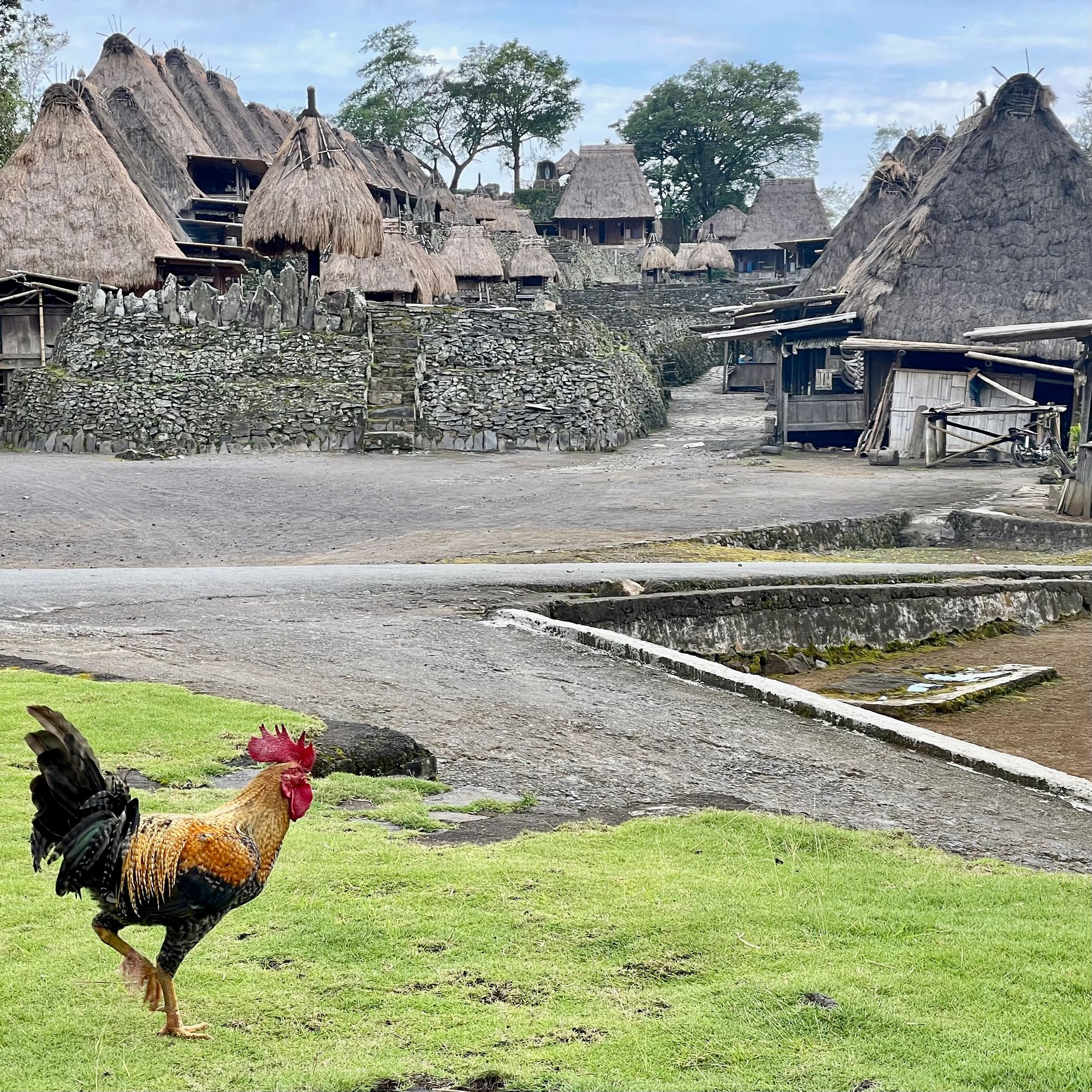
Bena is nestled at the foot of volcanic mount Inerie with one end of the village perched on top of a canyon with sweeping views down the green slopes leading all the way to the ocean.
It is postcard pretty, with two rows of identical wooden cottages with high thatched roofs, all facing a large square filled with what look like ceremonial structures and megalithic tombs.
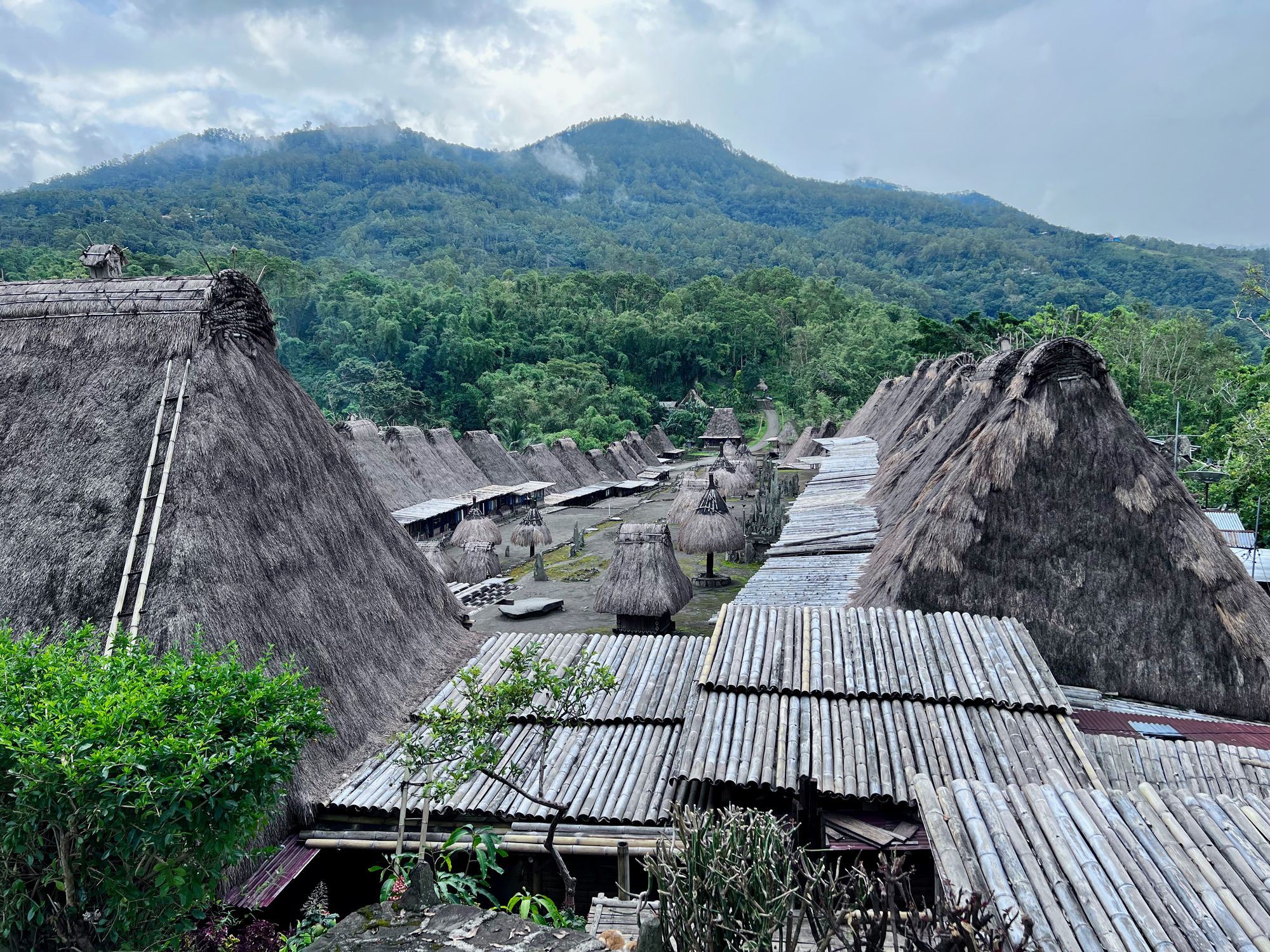

There is a group of small kids playing in the main square but the only other evidence of village life is a few women sitting and weaving on their front porches, with colourful weaved scarfs displayed for sale all along the front. There is a small fee for visiting here and it’s completely understandable that they’re taking advantage of the economic opportunity however it feels very quiet for a village. Either very few people live here or they're out working.

Paul explains that this is a matrilineal society where a man join the woman’s family after marriage. Evidence of their traditional animistic beliefs is everywhere, with wooden totems perched on top of the roof of every house and buffalo skulls and horns used as decorations on the front, meant to indicate family prosperity.
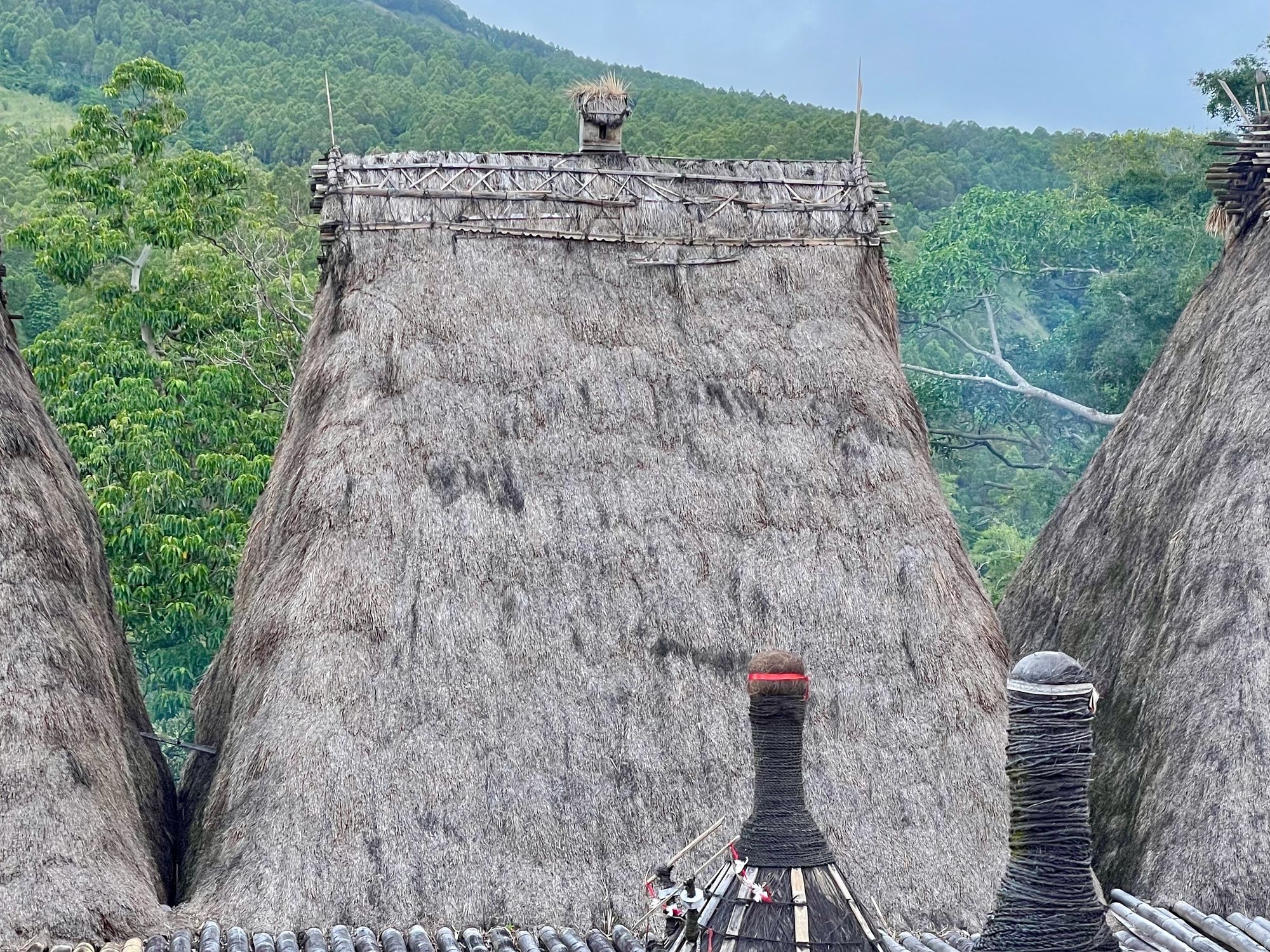
The main square is covered in tombs, miniture thatched houses and parasol structures, all forms of ancestral totems still relevant today; the villagers keeping tradition alive by regularly performing ceremonies to pay respect to their ancestors.

This custom of keeping the dead close by has definitely carried on into modern life here in Flores as we notice graves taking pride of place in the front yards of most houses on our drive to Bena. The graves are quite large and elaborately tiled, with decorative fencing and even roofs over some. Judging by their size in relation to actual houses, it seems that a considerable amount of the household budget goes towards giving the departed a prominent resting place.
We finish our village visit by buying one of the weaved scarves and head back to Riung to prepare for the two day tour we have organised for the next day. We’re all in bed early as it’s an early start tomorrow.
About 5 hours drive from Riung lies the Kelimutu National Park, a volcanic mountain with three crater lakes at the top which are famous for regularly changing colour. The plan is to drive to the town of Moni first, spend the night there then visit Kelimutu early the next morning. The drive is long but interesting, with mountains, rice fields, villages, jungle and volcanoes on the way.

We stop at Blue Stone Beach for lunch, and have one of the most delicious meals yet in Indonesia.

The beach itself is covered in stones ranging from blue to green in colour and very large to a pebble. Very scenic and not too much rubbish to spoil the view but definitely no swimming as the waves smash onto the beach with some force.

We get to Moni in early afternoon and check into our homestay. It’s a large room with an even larger bathroom with one queen and one king single bed. Paul booked us a ‘family’ room so there is a bit of a discussion on who is sleeping where. Graham and Jake will take the king single so everyone is happy. Well, Lara and I are.
Moni itself is a cute little mountain town with homestays, restaurants and quite a few visiting backpackers. We walk to a waterfall just out of town and after crossing a rickety bamboo bridge to reach it, we’re disappointed we can’t swim in it although it does quite nicely for a selfie.

We walk further along the path from the waterfall into a tiny little village then return to town for dinner at a hip looking hotel which looks very promising. Jake scores a burger and Graham a burrito, I eat a delicious vegetarian coconut curry and Lara sticks to nasi goreng (fried rice) proving her allegiance to Indonesian food. There are cold beers, fresh juices and a very cute puppy so the evening is a big success.
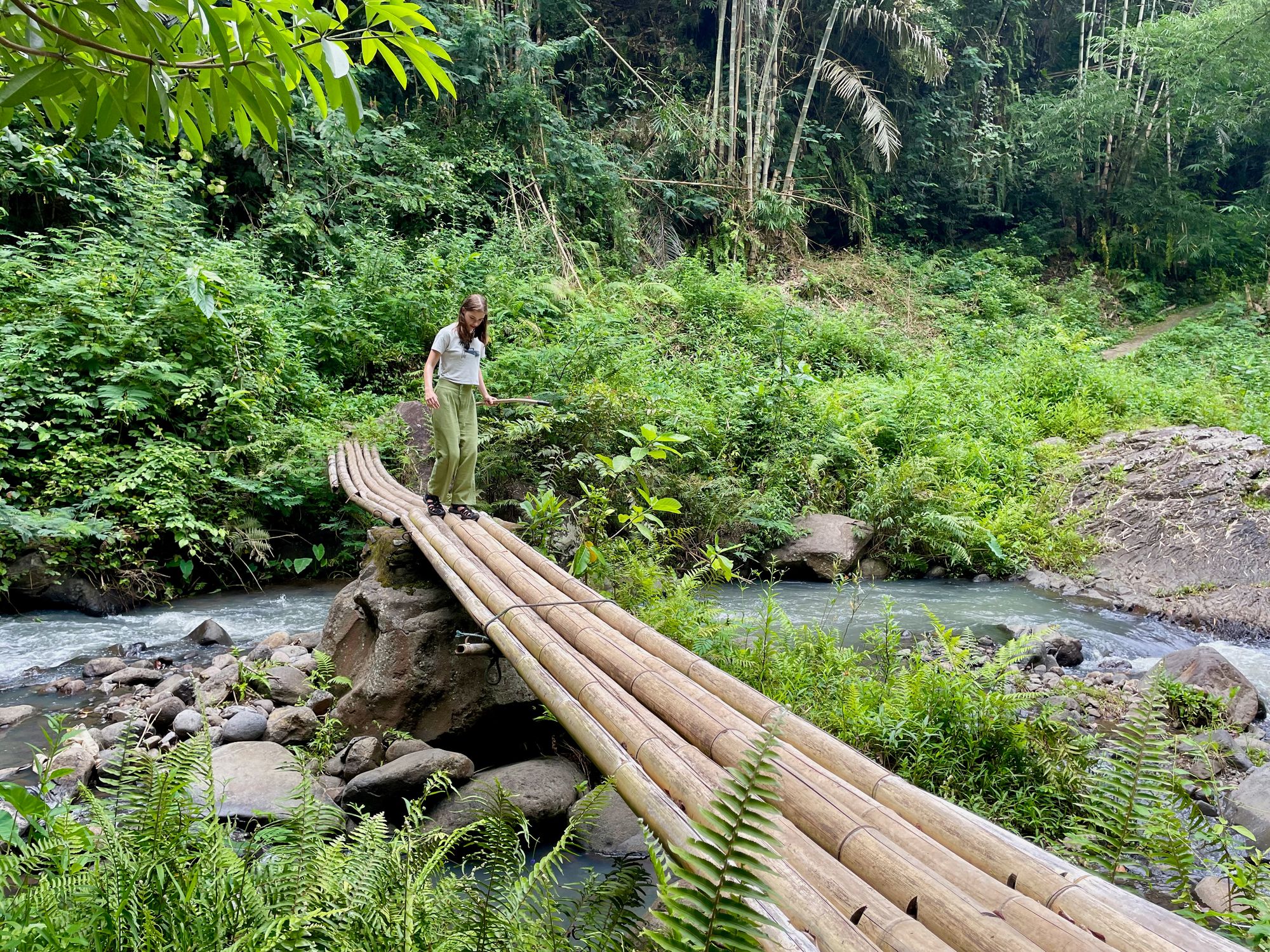
We decide to skip the sunrise tour of the lakes as no one is keen for a 4.30am start although when the local roosters wake me at 3am and I can’t fall back asleep due to their continuous crowing, I regret telling our driver to be ready at 8am. Everyone is up and ready at 7am and we eat a very delicious breakfast of banana pancakes with fresh fruit and very strong black Turkish coffee and fresh juice for the kids.

Moni is in the mountains and we were told to pack jackets. Three of us actually have jackets but we only wear them for about 5 mins in the morning before it gets too warm.
The national park is only a 30 minute drive and after paying our exorbitant entry fee (foreigners in Indonesia pay about 10 times the local price), we enter the park. Too late, we find out that today is a public holiday in Indonesia as it’s the first day of Ramadan and there are a few groups of local tourists there. It's not crowded by any strech of the imagination but we don't have the whole place to ourselves.
The path meanders uphill through lush forest and only fifteen minutes later, the blue of the first lake hits us. It’s so blue and the contrast to the volcanic rock so great, it is entrancing on first glance.
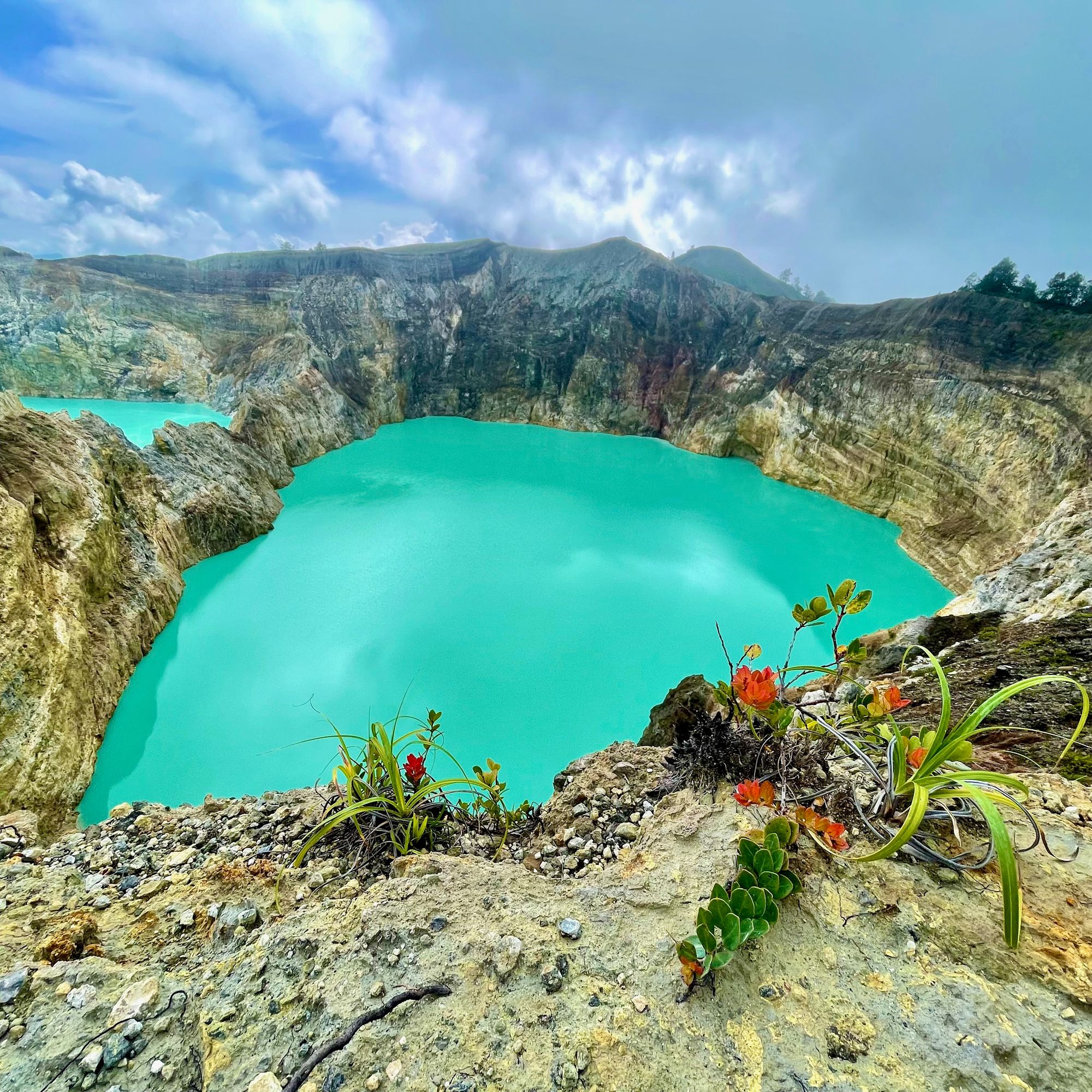
A macaw monkey jumps out of the bush and settles at the edge of the crater for a look at the lake but before I have a chance to nab a photo of the century, the kids squeal and scare it away. Not holding any grudges or anything but just thought I'd get it out of my system here.
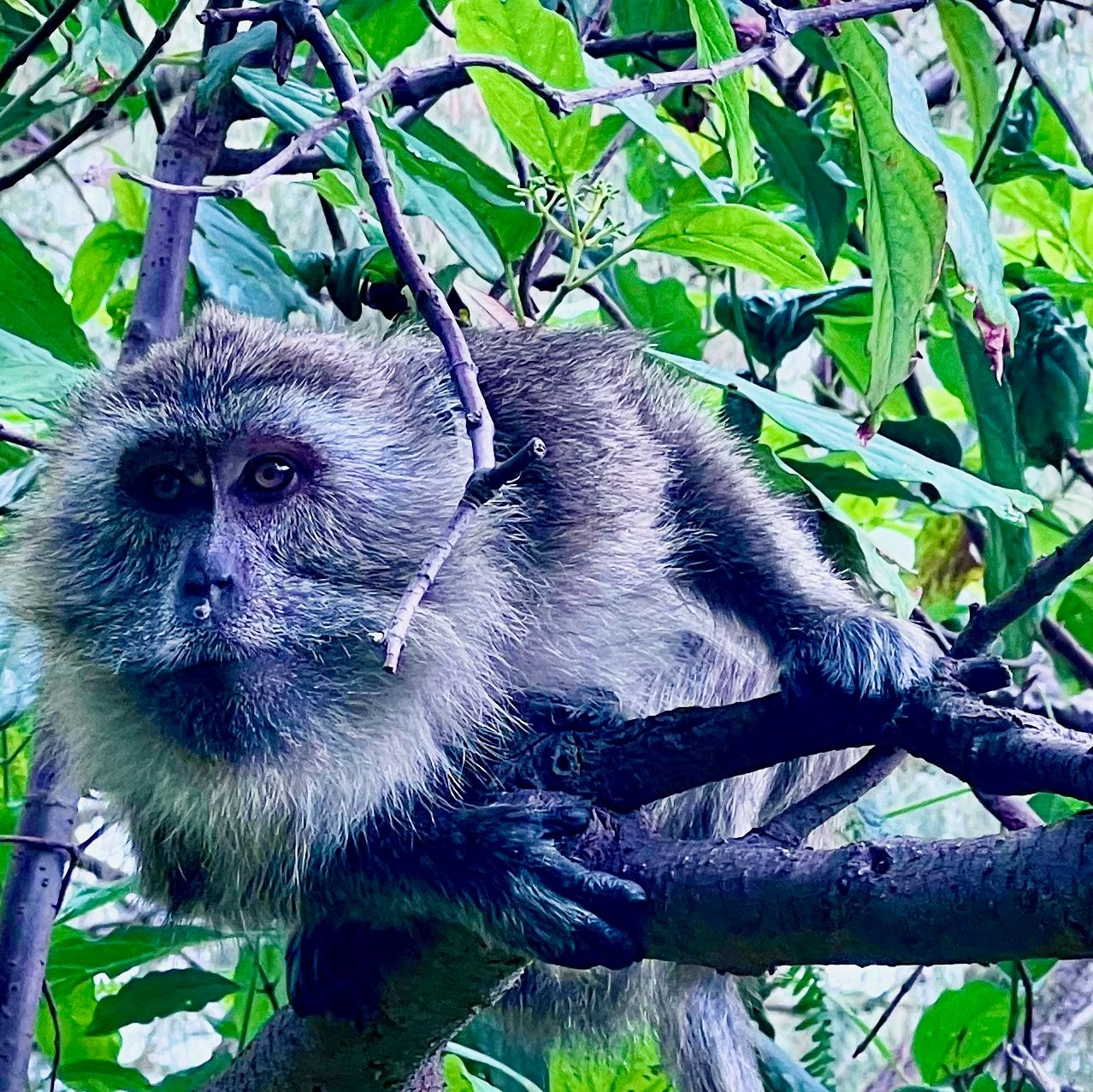
The Lio people who inhabit this area believe the three lakes hold the souls of their ancestors, neatly divided into the ‘good’, ‘so and so’ and ‘evil' lake. They hold traditional ceremonies here every year and bring food offerings to the dead as well as seek advice from them for the living.

The only slightly irritating factor are other tourists who repeatedly ask us for selfies. We mostly oblige but I say no to one woman who interrupts a quiet moment I have at the top looking at the 'good' lake which perhaps ironically is black and definitely the least impressive. When I eventually come down another woman from the same group again asks for a photo. I oblige and then they harass me for another 5 minutes to pose with them in various formations, with and without a hat, holding the baby etc. In the end I almost have to run away to get rid of them. Crazy.
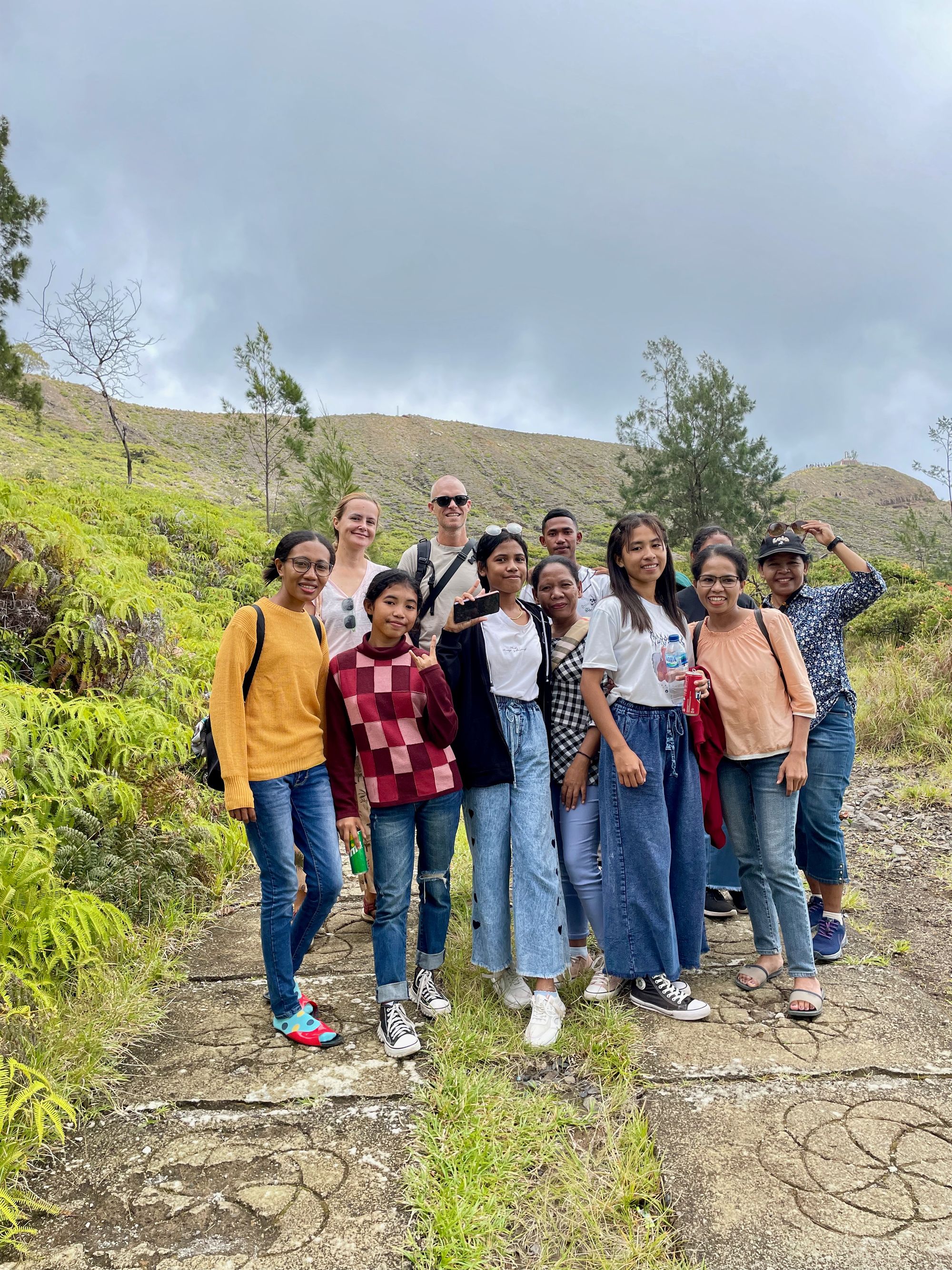
Kelimutu turns out to be one of the most impressive things we’ve seen yet despite the incessant request for photos and we’re really happy we chose to do it. The drive back is long but again we’re replenished by the delicious lunch at Blue Stone cafe and get back to the boat before dark.
Paul has asked the local fisherman to look after Ausbos while we’re away but there is still a bit of relief to find it floating when we return.

We manage to pick up fresh fruit and vegetables on our way back including some extremely cheap and delicious looking avocados (7 avocados for the equivalent of AUD$1!). We have a good night's sleep and get out of there early the next morning, destination west towards the mysterious and long-awaited Komodo Islands.